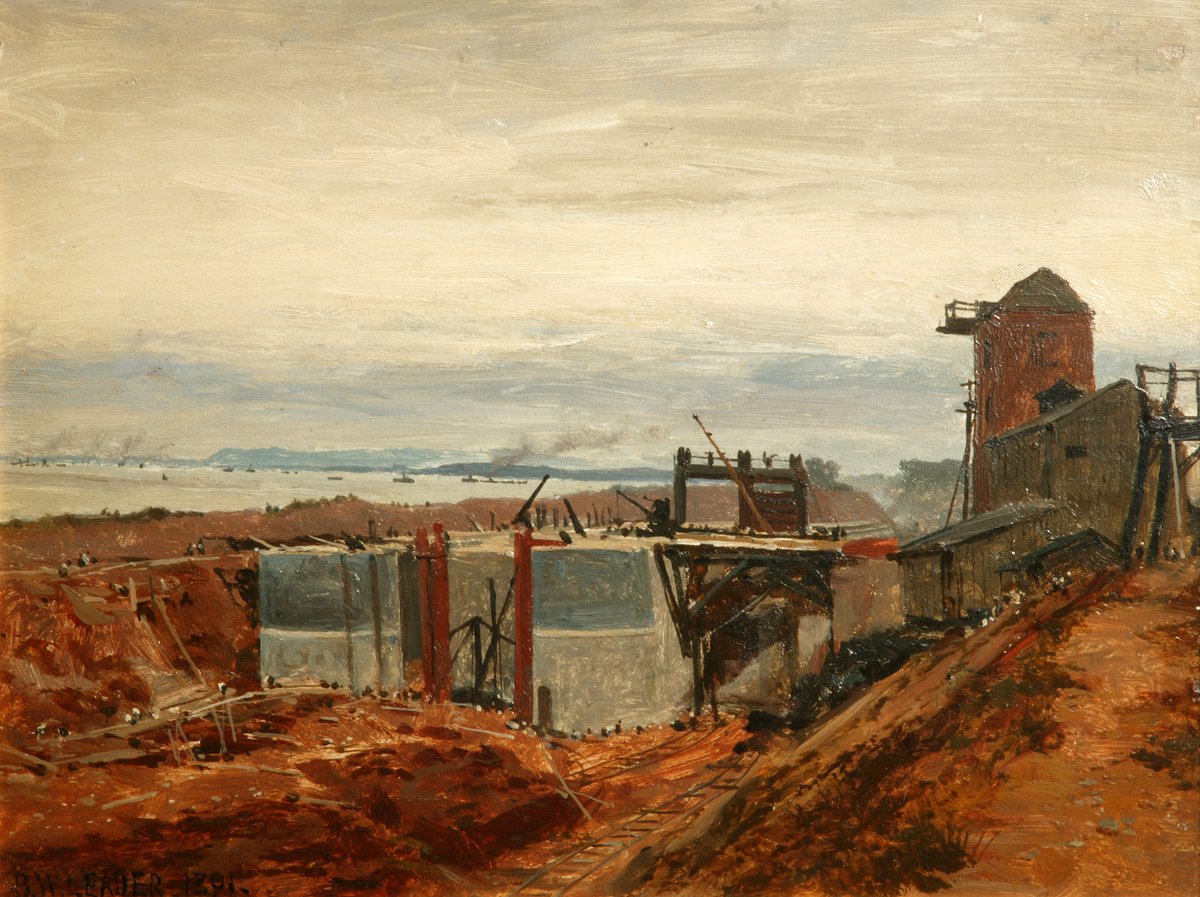This is the story of how one particular painting found its way onto our gallery walls. It was an uphill struggle, much like the tale of The Little Engine That Could. In Gallery 7, on the left-hand side of the long wall, you will find a row of paintings on a broadly agricultural theme. You might be forgiven if, on a casual glance, you mistook the one on the far left for a scene of potato harvesting in Lincolnshire, perhaps.
Gallery 7, Manchester Art Gallery
On closer inspection, you’ll find it is The Building of the Manchester Ship Canal, 1893, by Benjamin Williams Leader. It’s an oil painting showing the excavation of the ship canal cut somewhere close by what is now Eastham Docks near Liverpool, working its way towards Manchester.
Construction of the Manchester Ship Canal started in 1887. It took 17,000 men and boys six years to build the 36 miles of canal from Liverpool to Manchester. This is a little painting about a huge endeavour that speaks of industrial heritage and the civic pride of Manchester, the brushstrokes creating the marks of excavation. The navvies, digging, are barely more than dots.
The Building of the Manchester Ship Canal, 1891, by Benjamin Williams Leader (1831-1923) © Manchester Art Gallery (source)
Leader was best known as a painter of Constable-esque rural landscapes. We have several paintings by Leader in our collection, including February Fill Dyke, 1881, and At Evening Time there shall be Light, 1882, but The Building of the Manchester Ship Canal is currently the only work of his on display.
February Fill Dyke, 1881, by Benjamin Williams Leader ©Manchester Art Gallery (source)
How was it that a popular painter of country scenes got the job of depicting such a feat of Victorian civil engineering in the first place? Well, Benjamin Leader Williams came from a family of civil engineers. His father, Edward Leader Williams Senior, was a civil engineer, and his older brother, Edward Leader Williams Jnr. was, too. Benjamin, though, became an artist, He also changed his name to Benjamin Williams Leader to separate himself from the many other artists with the name Williams. Leader’s works were admired by the public but not the art world, whose critics often damned his pictures with faint praise calling them ‘popular and facile’ not to mention, ‘mechanical’, ‘painty’, and ‘artificial’.
Portrait of Benjamin Williams Leader (c.1890s) ©Royal Academy of Arts (source)
Even when commissioned to do this painting, it was mostly because of his brother, Edward, who was the Chief Civil Engineer on the Manchester Ship Canal. He sold the idea to Lord Egerton, the Chair of the Ship Canal Company, by telling him that his brother was good at painting ‘rain-filled rutty roads’. Leader took on the commission with vigour and produced several versions depicting the progression of the construction, several which are in the collection at Tatton Hall, the home of Lord Egerton. Along with the painting in our collection the series depicts a ‘time-lapse’ landscape of the digging.



Left, Sketch for 'The Excavation of the Manchester Ship Canal' (Eastham Cutting with Mount Manisty in the Distance) c.1890-91, Benjamin Williams Leader (1831–1923) (source) Centre, The Excavation of the Manchester Ship Canal: Eastham Cutting, 1891'. by Benjamin Williams Leader, R.A., (1831 -1923) Tatton Park (source) Right, The Building of the Manchester Ship Canal, 1891, by Benjamin Williams Leader (1831-1923) © Manchester Art Gallery (source)
There isn’t a lot about this painting of the building of the Ship Canal in our files, but there is enough to tell us it is something of an underdog.
When the Gallery was considering buying the painting back in 1991, the curator wasn’t keen, describing it in a hand-written note as “more social history than a work of art,” and even asking if the Ship Canal Company could buy it and ‘gift’ it to us. Eventually, when the Gallery bought it, with a purchase grant from the V&A, it was only considered good enough to hang out on the balcony, or in a special display on local history. In fact, if it wasn’t for the fact that Fauziya Johnson, artist, curator, producer, and co-director of ROOT-ed zine, chose to talk about it at a 2021 online gallery event, What we have learned about work during Covid-19 and what needs to change, then this painting would still languish in the Art Store.
And so, despite critical indifference to the artist and his work, here it is, in the biggest gallery in the building, surrounded by famous paintings and big-name artists. It has finally made it; “The Little Painting that Could.”
Detail of The Building of the Manchester Ship Canal, showing the navvies as dots of paint. © Manchester Art Gallery
Next time, in part two, using other works and objects in our collection, we’ll zoom in on the lives of the navvies and look at the human cost of such an engineering feat.





